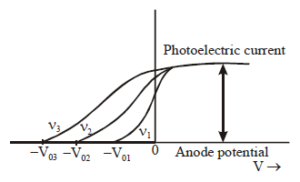The ratio of frequencies \[\frac{\nu_{1}}{\nu_{2}}\] of incident photons in graph shown will be :
No solution provided for this question.
The ratio of frequencies \[\frac{\nu_{1}}{\nu_{2}}\] of incident photons in graph shown will be :
No solution provided for this question.
If the momentum of an electron is changed by P, then de-Broglie wavelength associated with it
changes by 0.2%. The initial momentum of electron will be about :
No solution provided for this question.
In photoelectric effect, the curve between photoelectric current and anode potential V (for
different frequencies) is shown in figure, then :-

No solution provided for this question.
When the energy of the incident radiation is increased by 20%, the kinetic energy of the
photoelectrons emitted from a metal surface increased from 0.5eV to 0.8eV. The work
function of the metal is :-
No solution provided for this question.
The de Broglie wavelength of an electron moving with a velocity
\[1.5\times 10^{8}m/s\] is equal to that of a photon. The ratio of the kinetic energy of theelectron to the energy of the photon is :-
No solution provided for this question.
A 200 W sodium street lamp emits yellow light of wavelength 0.6μm. Assuming it to be 25%
efficent converting electrical energy to light, the number of photons of yellow light it emits per
second is :-
No solution provided for this question.
The ratio of wavelength of deutron and proton accelerated through the same potential difference will be :-
No solution provided for this question.
If the kinetic energy of the particle is increased to 16 times its previous value, the percentage
change in the de-Broglie wavelength of the particle is :-
No solution provided for this question.